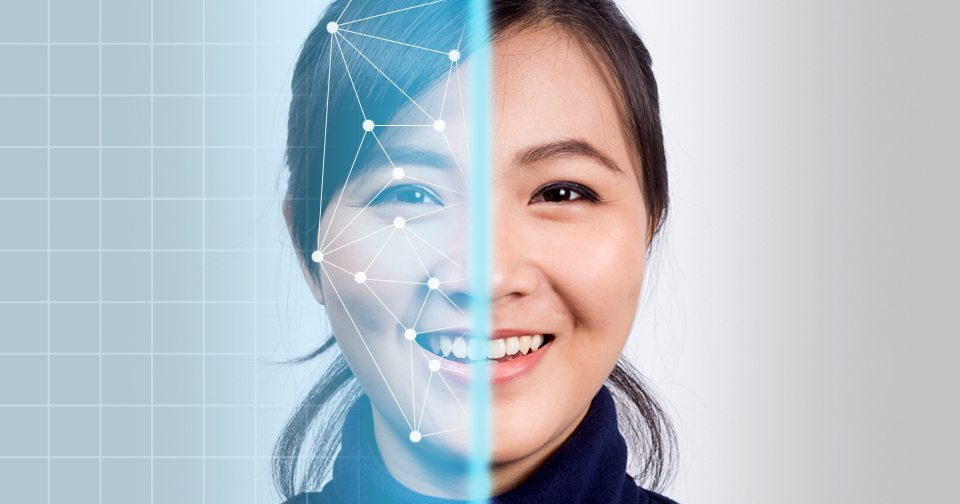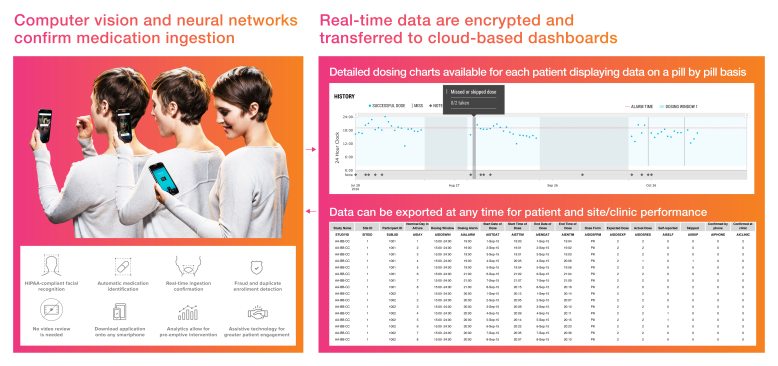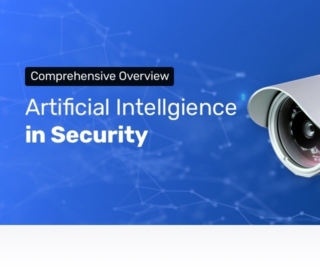
Facial recognition technology has been traditionally associated with the security sector but today there is active expansion into other industries including retail, marketing and health. By 2022, the global facial recognition technology market is projected to generate an estimated $9.6 billion in revenue with a compound annual growth rate (CAGR) of 21.3 percent*.
Comparatively, the general IT market is projected to earn $2.65 trillion in revenue by 2020, representing a 3.3 percent CAGR** from the period of 2015 to 2020. As market demand increases and industry-specific needs arise, many companies are exploring how AI can offer a competitive edge.
To gauge the growing impact of AI on facial recognition technology across industries, we researched this sector in depth to help answer questions business leaders are asking today, including:
- What types of AI applications are currently in use in the facial recognition technology sector – and how are they being implemented in industries such as security and healthcare?
- What tangible results have been reported on AI facial recognition applications that are being implemented across industries?
- Are there any common trends among these innovation efforts – and how could these trends affect the future of the facial recognition technology sector?
In this article we break down applications of artificial intelligence in the the facial recognition technology market to provide business leaders with an understanding of current and emerging trends that may impact their sector. We’ll begin with a synopsis of the sectors we covered:
Facial Recognition Applications Overview
Based on our assessment of the applications in the field today, the a majority of facial recognition use-cases appear to fall into three major categories:
- Security: Companies are training deep learning algorithms to recognize fraud detection, reduce the need for traditional passwords, and to improve the ability to distinguish between a human face and a photograph.
- Healthcare: Machine learning is being combined with computer vision to more accurately track patient medication consumption and support pain management procedures.
- Marketing: Fraught with ethical considerations, marketing is a burgeoning domain of facial recognition innovation, and it’s one we can expect to see more of as facial recognition becomes ubiquitous.
In the full article below, we’ll explore the AI applications of each application by section and provide representative examples.
(Readers with a deeper interest in healthcare, security, and marketing can read the specific sub-sectors in our blog [by clicking any of the three sub-sections above].)
Security
Trueface.AI – Fraud detection
Occasionally, facial recognition technology may not be able to distinguish between a human face and a photograph. As a result, this flaw can greatly compromise security efforts. In an effort to address this challenge, Trueface.AI, the developers of a facial recognition doorbell called Chui, are using deep learning and facial recognition technology to distinguish a human face from a photograph as depicted below.
Trueface.AI’s deep learning algorithm was reportedly trained on thousands of examples of “attacks” that the team collected over the years. It has been reported that Trueface.AI’s technology is being implemented by companies across a number of industries including healthcare and banking. However, the team is keeping the specifics under wraps for now.
Kairos – Fraud detection
Arguably one of the larger companies in the AI facial recognition space, Kairos uses machine learning and computer vision to run its suite of tools which include standard facial recognition features and other options such as gender, age and ethnicity detection. In the 3-minute video below, the Kairos team demonstrates the product in action and explains its major use-cases:
Since the company was founded in 2012, Kairos has reportedly raised $4.26 million in total equity funding from a combination of venture, angel, seed, and Series A and B investors. In 2015, the company made an estimated $2.7 million acquisition of IMRSV (a software company) that reportedly “turns any webcam into an intelligent sensor.” We covered Kairos in our popular previous article on applications of AI in IoT.
Kairos has published some case studies on its website to provide examples of its applications across multiple industries. For example, for one company Kairos claims that it identified $14.5 million in potential annual savings by identifying manual time card discrepancies.
Walmart – Shoplifting prevention
In the retail sector, major retailers appear to be exploring facial recognition technology for security purposes. However, some efforts have been met with consumer privacy concerns.
In 2015, Walmart reportedly began testing facial recognition in some of its stores in an effort to identify shoplifters but subsequently ended its use. The retail giant later publically acknowledged the tests and claimed that the technology did not provide an adequate ROI to justify continued use. It appears that the unfavorable publicity may have been one of the main reason behind this decision.
Saks Fifth Avenue – Facial recognition controversy
In 2016, speculation that Saks Fifth Avenue’s new Toronto location would utilize facial recognition made headlines. However, in response to an inquiry on the retailer’s twitter page, Saks denied any use of facial recognition technology at that particular location. However, during the Twitter exchange an attempt to clarify if the technology is used in Saks New York locations was not responded to.
@NicoleOzer Saks does not use facial recognition technology in our Toronto stores. The reports stating that we do are erroneous.
— Saks Fifth Avenue (@saks) March 5, 2016
One consumer survey revealed that 71 percent of millennials were uncomfortable with the idea of facial recognition technology being used where they shop. Another major challenge is data security concerns.
MasterCard Identity Check Mobile app – Account security
Passwords have become a burdensome cost of navigating the Internet environment. MasterCard is one of the financial institutions looking to circumvent the need for passwords through facial recognition.The MasterCard Identity Check Mobile app reportedly verifies online payments through either fingerprint or facial recognition. As depicted in the video below, app users are able to verify their payments by using their smartphone camera to capture a picture of their faces.
Results from a consumer survey distributed to 750 app users in the Netherlands revealed that 92 percent found the app “more convenient than passwords.” In a U.S. trial with 200 users, 86 percent of survey respondents found the app “easier to use than passwords.” MasterCard reports that the app is available in 14 countries and has recently expanded to Mexico and Brazil.
Other emerging efforts in the industry include Bank of America which is reportedly piloting a mobile banking app that processes user logins by scanning the eye.
Healthcare
AiCure – Medication adherence
Medication non-adherence or non-compliance occurs when a patient fails to take their medication as prescribed by his or her physician. This is a major challenge in the U.S., occurring among approximately 50 percent of patients who receive medication prescriptions. This trend translates to avoidable hospital admissions and a staggering $100 billion in estimated annual costs.
Founded in 2010, AiCure is an AI company using facial recognition technology and computer vision to improve medication adherence practices. The company’s algorithm-driven software is delivered through an app and AiCure claims that it can be accessed on any mobile device.
The app reportedly performs three core functions, it identifies the patient, identifies the prescribed drug and can visually confirm if the drug has been ingested by the patient. In the 1:30 minute video below, the AiCure team provides a simulated demonstration of how the app tracks medication adherence:
Dates and time stamp data are collected for each pill taken by the patient as depicted in the model below:

In a 2017 pilot study among 75 individuals with schizophrenia, over a period of 24 weeks, AiCure reported a 89.7 percent drug adherence rate compared to a 71.9 percent rate with a traditional drug adherence monitoring method. These results provide a window into how facial recognition technology could possibly impact healthcare outcomes and the economy.
Based on its website, the company does not appear to be focused on a particular disease or age demographic and appears interested in broad adoption of its technology across applicable medical conditions.
One research study has shown that higher medication adherence correlates with patients who have two simultaneously conditions (comorbidity) and a higher number of prescribed medications. Chronic conditions that had the lowest rate of adherence in this study were diabetes and asthma.
Companies like AiCure are poised to become increasingly relevant as the healthcare industry continues to integrate technology and AI solutions to improve patient outcomes.
ePAT – Pain management
An estimated 100 million Americans suffer from chronic pain, a figure equivalent to roughly one-third of the U.S. population. The annual associated medical costs have been approximated up to $630 billion. Globally, the figure is estimated at 1.5 billion individuals suffering from some degree of chronic pain.
In the healthcare setting, performing an accurate assessment of patient’s pain level is an imperfect science. Certain traditional pain assessment methods rely significantly on a patient’s description of his or her pain level. While non-verbal pain assessments tools are available, inherent bias, reliability and sensitivity are some of the challenges encountered regardless of the tool.
The facial recognition technology platform ePAT is a point of care app designed to detect facial expression nuances which are associated with pain. App users can also reportedly enter data on “non-facial pain cues” such as “vocalisations, movements and behaviours” which are then aggregated to provide a pain severity score as demonstrated in the video below:
In a pilot validation study of 40 dementia patients in Australia, results show that ePAT achieved a correlation coefficient score of ≥ 0.88 (the standard score range for a new pain assessment tool is 0.4–0.6) when tested against a standard Australian pain assessment. Some limitations of the study are acknowledged such as the “small sample size and non-random selection of participants.”
Marketing
FaceDeals – Target marketing
Applications of facial recognition technology in the marketing sector can potentially support efforts to improve customer loyalty. However, the technology has encountered challenges appealing to consumers due to privacy concerns.
https://youtu.be/sLOxUVvcjwE
For example, the app Facedeals aimed to target customers with special offers from businesses they frequent by integrating facial recognition with their Facebook profiles. Specifically, facial recognition cameras would be installed at the business entrance which would recognize customers as they enter. Simultaneously, the customer would receive a notification of a customized deal to their smartphone based on his or her Facebook “Like” history
Consumers did not take to the technology as anticipated which led Facedeals to reportedly change their name to Taonii, a mobile app that essentially performs the same functions without the facial recognition component. However, it is unclear how Taonii has performed. The company’s website provides limited info and its Facebook page has not been updated since its launch in 2014.
Other companies such as Listerine and Dutch coffee maker Douwe Egberts have integrated facial recognition technology into marketing campaigns or publicity efforts but applications that have produced hard data on customer retention have yet to reported.
Concluding Thoughts on the Future of Facial Recognition
Security is still considered the most prominent industry applying this technology. One reason for this trend is the importance of customer security across industries. With a projected CAGR of over 25 percent, the security sector is poised to continue to offer technology developers a robust market and provide investment opportunities for businesses.
Research has shown the need for more quality point of care mobile apps in the healthcare industry. Specifically, applications capable of delivering “meaningful, timely and accurate” results are highly desirable.
As existing companies continue to expand clinical research efforts to prove the efficacy of their facial recognition tools, implementation within the healthcare setting should increase. It is plausible that steady growth will occur in the next 3 to 5 years.
Among security applications in banking, industry players are taking a strong interest in using computer vision and facial recognition to eventually eliminate the need for passwords. As efforts expand, data security and privacy will continue to be primary challenges. At this early stage, facial recognition technology may be particularly at risk of fraud and may require more time before wider implementation occurs.
A similar trend is apparent among AI security applications within the retail industry. Companies are attempting to balance the possibilities offered by the technology while maintaining the bottom line and consumer confidence. Transparency regarding how retailers intend to use the facial recognition can be a double edge sword thus we expect the sector to more slowly adopt this technology.
We expect to see continued implementation of facial recognition technology across industries, with certain sectors leading the race when it comes to innovation efforts.
Header image credit: Acart Communications
* MarketWatch – http://www.marketwatch.com/story/facial-recognition-market-is-expected-to-reach-96-billion-worldwide-by-2022-2016-06-29-820323
* IDC – https://www.idc.com/getdoc.jsp?containerId=prUS42298417







